
A vibrant cinder cone rising majestically from a rugged volcanic landscape, surrounded by scattered volcanic rocks and green vegetation, showcasing the contrasting colors of black ash, deep red soil, and lush greenery under a bright blue sky with wispy white clouds.
Cinder cones, also known as scoria cones, stand tall above the earth. They are fascinating volcanic formations that grab the attention of geologists and outdoor lovers. These steep, conical hills are made of volcanic debris. They form around and downwind from a volcanic vent.
Lava fragments called cinders pile up to create these unique landscapes. They are visually striking and offer a glimpse into the earth’s volcanic past.
Key Takeaways
- Cinder cones are steep, conical hills of volcanic debris that form around and downwind from a volcanic vent.
- The lava fragments that make up cinder cones are called cinders.
- Cinder cones offer a glimpse into the powerful volcanic activity that has shaped our planet’s geology.
- These unique landforms create diverse landscapes that support a variety of flora and fauna.
- Exploring cinder cones provides outdoor enthusiasts with opportunities for adventure and scenic hiking experiences.
Unraveling the Mysteries of Cinder Cones
Cinder cones, also known as scoria cones, are fascinating volcanic landforms. They have captivated scientists and nature lovers for a long time. These unique features form through a special volcanic eruption process. Their distinct look has made them a global fascination.
What are Cinder Cones?
Cinder cones are made of loose, pyroclastic fragments, or cinders, from a single volcanic vent. These cinders are rough, light, and porous. They appear reddish-black or dark gray. The cones’ steep, symmetrical slopes can be small hills or tall mountains, adding to their striking beauty.
Formation Process of Cinder Cones
The formation of a cinder cone starts when magma reaches the surface. The gases in the molten rock expand quickly, causing an explosive eruption. This event throws lava fragments into the air, which pile up around the volcanic vent. Over time, this builds the cone-shaped structure.
The cone’s size and shape depend on several factors. These include the viscosity of the lava, the force of the eruption, and how long the volcano is active.
“Cinder cones are a testament to the power and beauty of volcanic processes, showcasing the incredible forces that shape our planet.”
Learning about cinder cones helps us appreciate these amazing geological features. They play a key role in the ever-changing landscapes they are a part of.
Cinder Cone: Nature’s Explosive Artistry

A breathtaking volcanic landscape featuring towering cinder cones, lush green vegetation contrasting with dark lava flows, a vibrant sunset casting warm tones over the rugged terrain, billowing smoke gently rising into a clear sky, and scattered volcanic rocks creating an intriguing foreground.
Cinder cones are a stunning part of volcanic landscapes. They not only look amazing but also change the area around them. These structures affect the local geology and create unique ecosystems.
The creation of a cinder cone starts with a volcanic eruption. Lava bits are thrown into the air and cool down, forming cinders. These cinders pile up around the vent, making the cone’s steep shape.
Cinder cones have a big impact on the local geology. They can change the land, making new shapes and homes for plants and animals. The lava and debris also change the soil, helping certain plants grow.
But, cinder cones also bring risks. People living near volcanoes need to know about these dangers. Knowing how cinder cones work helps keep communities safe.
“Cinder cones are not only visually striking, but they also play a significant role in shaping the surrounding landscapes.”
Cinder cones are not just beautiful; they also deeply affect the environment. By studying them, we learn about the forces that shape our planet. This knowledge helps us understand the world around us.
Exploring the Diverse Landscapes of Cinder Cones

A scenic view of hikers traversing a rugged cinder cone landscape, featuring steep volcanic slopes, scattered black and reddish boulders, and vibrant patches of green vegetation, under a clear blue sky with wispy clouds in the distance.
The harsh, rocky environments of volcanic cinder cones are home to unique plants and animals. These areas show how life can thrive in tough conditions. They offer a peek into the resilience and adaptability of life in these special ecosystems.
Unique Flora and Fauna
The biodiversity in cinder cone landscapes is amazing. These volcanic formations support a variety of plants, from hardy grasses to resilient trees. They also attract animals, from small rodents to larger predators, thanks to their unique habitats.
Hiking and Adventure Opportunities
Cinder cones are great for outdoor fun and adventure tourism. Many are easy to reach and have hiking trails. These trails let visitors see these unique landscapes up close. They offer stunning views and insights into Earth’s geological history.
| Hiking Trail | Difficulty Level | Estimated Duration |
|---|---|---|
| Cinder Cone Trail | Moderate | 2-3 hours |
| Lava Flow Trail | Difficult | 4-6 hours |
| Crater Rim Loop | Challenging | 3-5 hours |
“Exploring the cinder cones is like stepping into a different world – a volcanic wonderland that challenges the senses and inspires awe.”
Conclusion
Cinder cones are a fascinating part of Earth’s history. They show us the power of nature with their unique shapes and colors. These volcanic wonders tell us about the forces that shape our planet and the life that thrives there.
Visiting cinder cones lets us connect with nature’s beauty. They inspire us to appreciate the amazing geological processes that make our world. These formations are home to a wide range of plants and animals, showing life’s ability to adapt to harsh conditions.
As we learn more about cinder cones, we see their big impact on our environment. They remind us of the need to protect these natural wonders. By understanding cinder cones, we can work towards a future where we value and preserve the beauty of our world for future generations.
Important Point
| NO. | Important Points |
| 1. | About Us |
| 2. | Contact Us |
| 3. | Disclaimer |
| 4. | Privacy Policy |
FAQs of Cinder cone
What are cinder cones?
Cinder cones, also known as scoria cones, are steep hills of volcanic debris. They form around and downwind from a volcanic vent. The lava fragments are rough, lightweight, and porous, making the cone look reddish-black or dark gray.
How do cinder cones form?
Cinder cones form through a specific volcanic eruption process. As magma rises, the gases in it expand rapidly, causing an explosive eruption. This event throws lava fragments into the air, which then pile up around the vent, building the cone.
What is the impact of cinder cones on the surrounding landscape?
Cinder cones can greatly change the local geology, altering the terrain and creating unique ecosystems. The harsh, rocky environments support specialized plants and animals. They show how life can thrive in these dynamic volcanic landscapes.
What are the outdoor recreation opportunities associated with cinder cones?
Cinder cones offer exciting outdoor adventures. Many are accessible and have hiking trails. Visitors can explore these unique landscapes up close, enjoying stunning views and learning about geological processes.
What is the significance of studying cinder cones?
Studying cinder cones gives us insights into the Earth’s geological history. By understanding these volcanic wonders, we learn about the forces shaping our planet and the ecosystems they support. Exploring cinder cones connects us with nature’s power and beauty, inspiring a deeper appreciation for our world.
